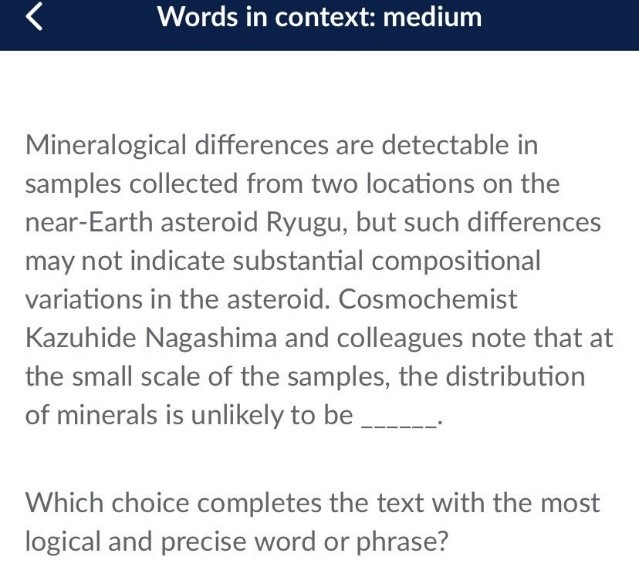Some time ago, I had this very insightful conversation with one of my students, and together we came up with an incredibly helpful skill to apply to the vocabulary-in-context question on the New DIGITAL SAT...
As you know, learning does not happen in a vacuum, right? And there is no end to the well of tips to tap from in dealing with the tricky questions that come up on the SAT sometimes.
You must also know that I ABSOLUTELY love to intellectually engage my students in off-classroom set-ups. I mean, if anything, the route to your success at this exam has to be steady and consistent! And the more unstifled, unregimented the learning environment is, the better. In that spirit, I'm very glad to share this wonderful tip with you.
Hang in there a second...
The particular question that engendered the conversation will be shown first...
You can try working through it your way, then later see whether the technique deployed in the conversation helps you deal with it within a shorter time... But first, you have to listen with intention!

SAT STUDENT: Sir please check this question
MR CHRIS: You know you have to understand the context of the information before the contrast as indicated by the “but”, right? In other words, you have to determine whether that context is a positive or negative one. Hence, your clue begins from "but such "difference" may not indicate substantial compositional "variations" And before the detail you have before the blank "the minerals are unlikely to be_____"
SAT STUDENT: Yes I know the context before the “but” is negative, but I don’t still get it why the right answer is right?
MR CHRIS: First, The context after the 'but' is negative or positive?
SAT STUDENT: Negative
MR CHRIS: Good. It then means that everything after is negative right?
SAT STUDENT: Yes
MR CHRIS: And then you have a negative word before the blank, right?
SAT STUDENT: Yes yes
MR CHRIS: Negative × positive=?
SAT STUDENT: Negative
MR CHRIS: Good.
SAT STUDENT: The word you need for that blank has to be what now?
MR CHRIS: Negative or positive?
SAT STUDENT: Negative for that context
MR CHRIS: Hold on a little, the context you need is a negative one. But where you then have a negative word already before the blank nko?
SAT STUDENT: Okay you would need positive so that they can cancel to still give you negative?
MR CHRIS: Beautiful! Now choose an answer
SAT STUDENT: It’s UNIFORM
SAT STUDENT: I get it now
MR CHRIS: Remember that we are working with the keywords "differences" and "variations"
SAT STUDENT: So anytime a negative word comes before the blank, we are to find a positive word as the answer?
MR CHRIS: Yes, BUT if the context we need is negative.
MR CHRIS: Brilliant. Read it into the text now and see how it makes sense in the context.
“Mineralogical differences are detectable in samples collected from two locations on the near-Earth asteroid Ryugu, but such differences may not indicate substantial compositional variations in the asteroids. Cosmochemist Kazuhide Nagashima and colleagues note that at the small scale of the samples, the distribution of minerals is unlikely to be UNIFIORM."
SAT STUDENT: Yes that is why it is unlikely for it to be uniform because of the differences
MR CHRIS: Brilliant.
SAT STUDENT: Okayy
SAT STUDENT: Thank you sir
MR CHRIS: Whereas if the context we need is positive and we have a negative word before the blank, what word do we need? Negative or positive?
SAT STUDENT: Negative
MR CHRIS: Beautiful. Negative × negative= positive
SAT STUDENT: Okay, thank you sir
MR CHRIS: You're welcome
MR CHRIS: Continue with your practice
SAT STUDENT: Okayy
SAT STUDENT: Sir I got everything in my practices so far
SAT STUDENT: Send me more questions on it if you have iyehh…
Most importantly, you should take note of the based-on-the-text approach we utilized here. This works for virtually all the questions in the verbal section.
So, there you have it. I hope you found the conversation both interesting and helpful too, as I have had a good number of students who confessed to how instrumental it was in helping them get by tricky vocabulary-in-context questions during practices.
If you noticed, I left the conversation just the spontaneous, natural way we had it with all our Nigerian colloquialisms of course. I do hope you didn’t mistake them for the wrong spellings of Standard English words. *chuckle*…
Anyhow, for a fuller, well-structured class session on this and the other question types on the New Digital SAT (verbal section), sign up for the pre-recorded course right below or reach out for one-on-one guidance. SAT- MAIN – Chigozie Nwokoji





0 comments